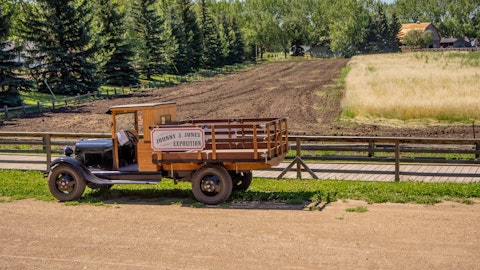My understanding is that most of these two particular projects are done in 2023 and how much of an expansion CapEx we could see carry over for the business into 2024? That would be it. Thank you.
Mariano Bosch: Okay. Thank you, Thiago, for your question. Renato, do you want to answer and then I can complement.
Renato Junqueira Pereira: Okay. So hi, Thiago. Thank you for your question. So regarding the cost, we think that there are some components of the cost that is going to increase, such as labor that increase according to inflation, freight that is still under pressure. But there are other factors also in the numerator part of the costs that are decreasing, such as inputs in general. So I would say that the numerator part of the cost is almost flat year-over-year. But the denominator part, I think is going to make the difference in our case. We –as I mentioned before we still believe that we’re going to crush more sugarcane this year compared to last year. So this dilutes our cost more. So we expect a cost similar or slightly lower than we had last year.
And regarding the question about the CapEx, I think the CapEx that we are projecting to do is exactly what we mentioned is the expansion of our planting to fulfill our capacity in MatoGrosso do Sul and also the biodigester expansion, we plan to increase our production of biomethane in MatoGrosso do Sul from 6 to 30,000 cubic meters per day in the next four years. So that’s basically the CapEx that we are planning to do.
Mariano Bosch: Very clear, Renato. And Thiago, just to complement, I wanted to make more open on our CapExes for this year and this has a lot to do with the capital allocation and how we think about it. First of all these results that we are seeing today and this increase in distribution because of the increase of net cash operations are the clear consequence of all the investments that we’ve been doing during these years. So today we still see a lot of growth opportunities and as Renato was explaining on the sugar and ethanol we have this clear opportunity on increasing this continue to increase the sugarcane plantation that is very efficient in this specific area continue to increase the biodigesting of the vinyas that then is transformed into a biofertilizer so the whole system still has a lot to grow and a lot to replace the diesel et cetera.
So that is on the sugar and ethanol that there are many other things that are also very interesting. On top of this we have this expansion projects in the rice business. As you’ve seen in the rice business we’ve been growing and the results are clearly paying off. The same thing we have for the dairy. There are some opportunities that we think are very attractive. So we can expect this to continue to happen what you’ve been seeing in the last years. But this also means that we are fully convinced of our distribution policy we put in place this fully — this distribution policy 2.5 years ago and we are following that very closely. We are fully committed to this and we are doing through both dividends and buybacks as Emilio explained and the dividends are something you will be seeing the $35 million and on top of that you saw that we bought back a $1.18 million of shares that is 1.7% of the company in only two months.
So that is something that we expect or you can see to continue to happen, that is above the policy and most of the years we’ve been going above the policy and the policy says at least. So that’s a view or a clearance something that we are clearly thinking on. So that was to complement the concept of how we think about the CapEx and capital allocation.
Thiago Duarte: That’s great, Mariano. Thank you for the additional color.
Operator: If you have a question, please write it down in the Q&A section or click on raise hand for audio questions. Please remember that your company’s name should be visible for your question to be taken. We do ask that when you pose your question that you pick up your headset to provide optimum sound quality. Please hold while we pull for questions. Next question from Larissa Pérez with Itaú BBA. You can activate your microphone.
Larissa Pérez: Hi guys. Good morning, Mariano, Emilio, Renato, Victoria, all the Adecoagro team. Thank you for taking my question and congratulations on the results once again indeed very resilient. I was wondering if you could share with us your thoughts on La Niña impacts because the probability of La Niña coming back by the second half of this year has been steadily increasing. And I wanted to hear from you, how much do you think it could impact both the Argentinean farming division and the Brazilian sugar and ethanol division? That would be my first question regarding the impacts on the second semester and the beginning of next year. And my second question would be on the process of SAF certification. Congratulations on getting the Angelica mill certified for SAF production.
I would like to understand if you’re planning on certifying your other mills? And what are the next steps here that you envision towards supplying ethanol for SAF production? Those would be my two questions. Thank you once again.
Mariano Bosch: Okay, Larissa, thank you for both questions. I’m going to take some time to go in detail because I think are very relevant. First of all on La Niña year, we need to be clear we are all hearing about La Niña year coming ahead of us. This is totally different to what happened the previous year because now would be a La Niña year after El Nino year. The great issue that we had with La Niña the previous year was because of a third consecutive year of La Niña and this is a very different situation than what we have today where we have most of the reservoirs full and then you have a La Niña effect. That of course will have effects that I will go in detail in a segment-by-segment case and how this can how can this affect us.




